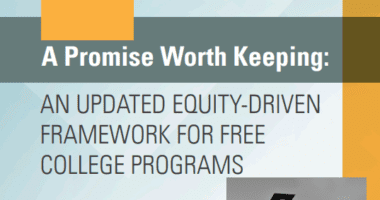Unlock the possibilities of higher education for more students by requiring that all students complete applications for financial aid
Increasingly, employers are demanding that job applicants possess far greater education and training than ever before. To pursue their career goals, many students will need to continue their education after high school graduation.
Unfortunately, with the rising cost of tuition, higher education feels out of reach for them. This is especially true for students from low-income backgrounds and first-generation college-goers.
Help is Available
While there are numerous state and federal resources available to pay for college and career training, many students and their parents lack the information and guidance on how to access these tools. The first step towards unlocking financial aid is filling out the Free Application for Federal Student Aid (FAFSA).
The FAFSA is a free application that provides access to the largest source of financial aid to help pay for college or career school and can determine eligibility for state aid. In addition, many colleges and universities require the FAFSA for institutional and merit-based aid. The form determines the amount of money a family is expected to contribute to the price of attending a postsecondary institution. It is used by the federal government, colleges, and universities to determine eligibility for grants or loans.
Michigan Trails Leading States
Yet in Michigan, too many students fail to realize the resources available for them to go to college. Just over 50 percent of eligible Michigan students in the class of 2023 have completed their FAFSA application. This puts Michigan 31st compared to other states, and we significantly trail leading states like Tennessee and Louisiana.
Because of the low completion percentage, thousands of Michigan students are leaving an estimated $100 million on the table that could be used to pay for their education. Simply filing the FAFSA is considered a leading indicator of whether students will pursue college.
The Education Trust-Midwest has looked at leading states to determine why their students were completing the FAFSA at a higher rate. What we found is that many of those states passed laws tying completion of the FAFSA to high school graduation. After those laws passed, the states saw dramatic increases in the percentages of FAFSA completions. Now, Michigan should follow their lead.
An Opportunity to Boost FAFSA Completion
Sen. Darrin Camilleri has recently introduced Senate Bill 463. As part of his legislation, FAFSA completion will be a condition of graduation, and students will be provided with the assistance and resources to understand and complete the application. Communication and education are key because many families are either skeptical of filling out the form or simply do not understand the importance of it.
To address concerns raised about how this bill will impact undocumented students or students whose parents cannot or will not fill out the form, the bill allows for a broad parental waiver, as well as the option for a school district to waive the requirement for those students. That is important because no student should be negatively impacted or prevented from graduating under this bill.
Michigan has a long way to go to increase college attainment and meet Gov. Whitmer’s goal of having 60% of working-age Michiganders hold a certificate or college degree by 2030. Ensuring all students are applying for their financial aid opportunities is a great way to start.
No student should feel like attending college is not a possibility because of the cost. Completing the FAFSA will make all students – and particularly students from low-income backgrounds – more aware of the resources available. This is key to unlocking the idea that attending college is a viable option for all students.



